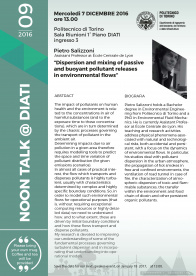09 - NoonTalk@DIATI
Mercoledì 7 dicembre 2016 - ore 13:00
DISPERSION AND MIXING OF PASSIVE AND BUOYANT POLLUTANT RELEASES IN ENVIRONMENTAL FLOWS
Sala Riunioni 1° Piano DIATI ingresso 3, Politecnico di Torino - Corso Duca degli Abruzzi 24, Torino
Seminario con Pietro Salizzoni
BIOGRAFIA
Pietro Salizzoni holds a Bachelor degree in Environmental Engineering from Politecnico di Torino and a PhD in Environmental Fluid mechanics. He is currently Assistant Professor at École Centrale de Lyon. His teaching and research activities address physical phenomena associated with natural and technological risks, both accidental and persistent, with a focus on the dynamics of environmental flows. In particular, his studies deal with pollutant dispersion in the urban atmosphere, the propagation of hot smokes in free and confined environments, the ventilation of road tunnel in case of fire, the characterization of atmospheric dispersion of toxic and flammable substances, the transfer within the environment and food chain of dioxin and other persistent organic pollutants.
ABSTRACT
The impact of pollutants on human health and the environment is related to the concentrations in air of harmful substances (and to the exposure time to these concentrations), which are in turn determined by the chaotic processes governing the transport of pollutant in the ambient air. Determining impacts due to air pollution in a given area therefore requires modelling tools to predict the space and time variation of pollutant distribution (for given emissions scenarios). In almost all cases of practical interest, the flow which transports and disperses pollutants is highly turbulent, usually with characteristics determined by complex and highly specific boundary conditions. So, in order to model such environmental flows for operational purposes (that is, without requiring exceptional computing resources or highly detailed data) we need to understand how, and to what extent, these are driven by initial boundary conditions and how these flows transport and disperse pollutants. My research is devoted to improving our understanding of some of the fundamental processes governing turbulent dispersion and in incorporating that understanding into operational models.

